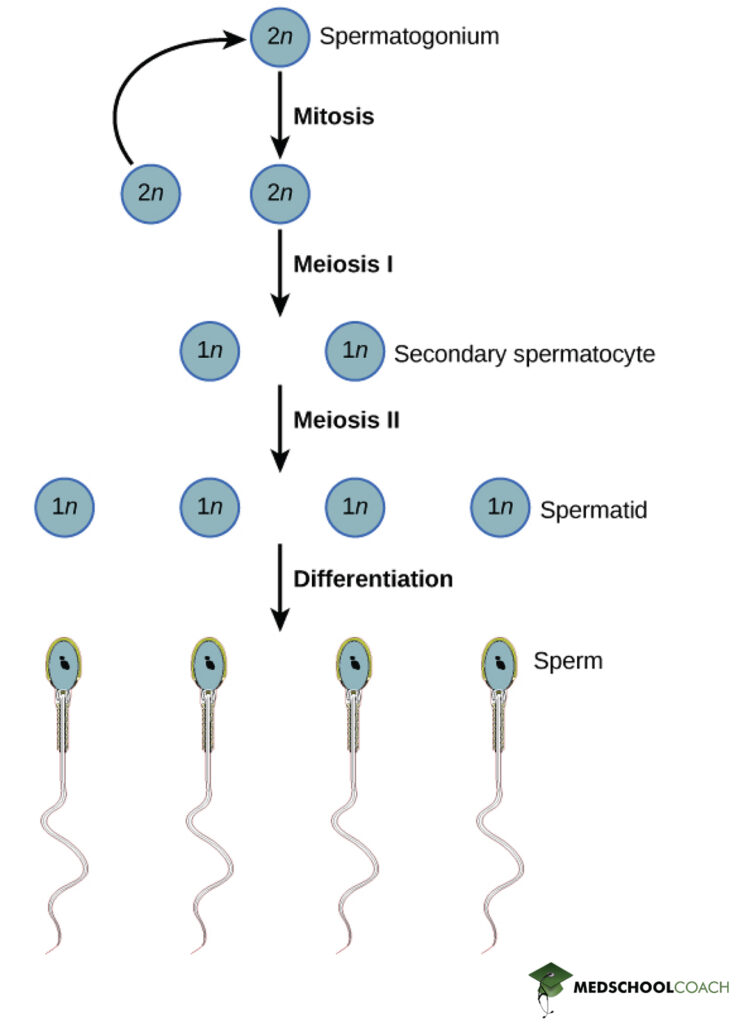Spermatogenesis
MCAT Biology - Chapter 6 - Section 1.1 - Reproduction & Development - Spermatogenesis
- Home
- »
- MCAT Masterclass
- »
- Biological and Biochemical Foundations of Living Systems
- »
- Biology
- »
- Spermatogenesis – MCAT Biology
Sample MCAT Question - Spermatogenesis
During spermatogenesis, what results from the second round of meiosis?
a) A secondary spermatocyte
b) Four identical spermatozoa
c) A primary spermatocyte
d) Four identical spermatids
D is correct. Four identical spermatids.
The process of spermatogenesis involves various steps of cell division. In the beginning, the single diploid spermatogonium undergoes mitosis to form another diploid spermatogonium and the diploid primary spermatocyte. The primary spermatocyte then undergoes meiosis I to form two haploid secondary spermatocytes. The two haploid secondary spermatocytes undergo meiosis II to form four haploid spermatids. The spermatids are immature sperm cells and enter the epididymis to undergo maturation to form spermatozoa.
Get 1-on-1 MCAT Tutoring From a Specialist
With MCAT tutoring from MedSchoolCoach, we are committed to help you prepare, excel, and optimize your ideal score on the MCAT exam.
For each student we work with, we learn about their learning style, content knowledge, and goals. We match them with the most suitable tutor and conduct online sessions that make them feel as if they are in the classroom. Each session is recorded, plus with access to whiteboard notes. We focus on high-yield topics if you’re pressed for time. If you have more time or high-score goals, we meticulously cover the entire MCAT syllabus.
Spermatogenesis
This MCAT post discusses spermatogenesis, the process by which sperm, the male gamete cell, is formed. This process starts at puberty and continues until the male dies. Note that this fact is in contrast with oogenesis that occurs cyclically in females from puberty to menopause.
Sperm formation requires two conditions. First, the temperature for sperm production must be lower than body temperature. Thus, the scrotum and testicles are not located directly inside the body, and can rise or drop depending on body temperature. The second condition is that spermatogenesis requires high concentrations of testosterone.
The Role of Sertoli Cells, Leydig Cells, and Spermatogonia
The testes, the site of spermatogenesis, contain several types of cells. In the walls of the seminiferous tubules, which make up a majority of the testes, are the Sertoli cells. The Sertoli cells secrete androgen binding protein, which binds testosterone, helping concentrate the testosterone to the high levels necessary for spermatogenesis. Also, scattered in between the seminiferous tubules are the Leydig, or interstitial, cells. The Leydig cells secrete the testosterone that androgen binding hormone will eventually bind. Lastly, there are the spermatogonia, which are the stem cell precursors to sperm. These cells are constantly renewed in males, allowing for spermatogenesis throughout the entire duration of the male’s life from puberty onward.
Process of Spermatogenesis
The process of spermatogenesis (Figure 1) begins with a single spermatogonium, which is a diploid cell containing 46 chromosomes. The spermatogonium undergoes mitosis to form two diploid, identical daughter cells. One of the newly created daughter cells will continuously undergo mitotic division as a spermatogonium, ensuring a constant supply of stem cells. The other cell will become the primary spermatocyte and undergo meiosis. At the end of meiosis I, the diploid primary spermatocyte splits into two haploid secondary spermatocytes, which each contain 23 chromosomes. The secondary spermatocytes then undergo meiosis II, resulting in four haploid daughter cells called spermatids. These spermatids are immature sperm cells and are not yet motile. They will be stored in the epididymis while they mature. Once the maturation process is complete, the mature sperm cells are referred to as spermatozoa (singular spermatozoon). The spermatozoa are haploid, mature sperm cells that are motile, fully functional, and capable of fertilization.

Explore More MCAT Masterclass Chapters
Take a closer look at our entire MCAT Masterclass or explore our Biochemistry lessons below.

One-on-One Tutoring
Are you ready to take your MCAT performance to a whole new level? Work with our 99th-percentile MCAT tutors to boost your score by 12 points or more!
See if MCAT Tutoring can help me
Talk to our enrollment team about MCAT Tutoring

MCAT Go Audio Course
Engaging audio learning to take your MCAT learning on the go, any time, any where. You'll be on the way to a higher MCAT score no matter where you are. Listen to over 200+ lessons.

MCAT Practice Exams
Practice makes perfect! Our mock exams coupled with thorough explanations and in-depth analytics help students understand exactly where they stand.

MCAT Prep App
Access hundreds of MCAT videos to help you study and raise your exam score. Augment your learning with expert-created flashcards and a question banks.